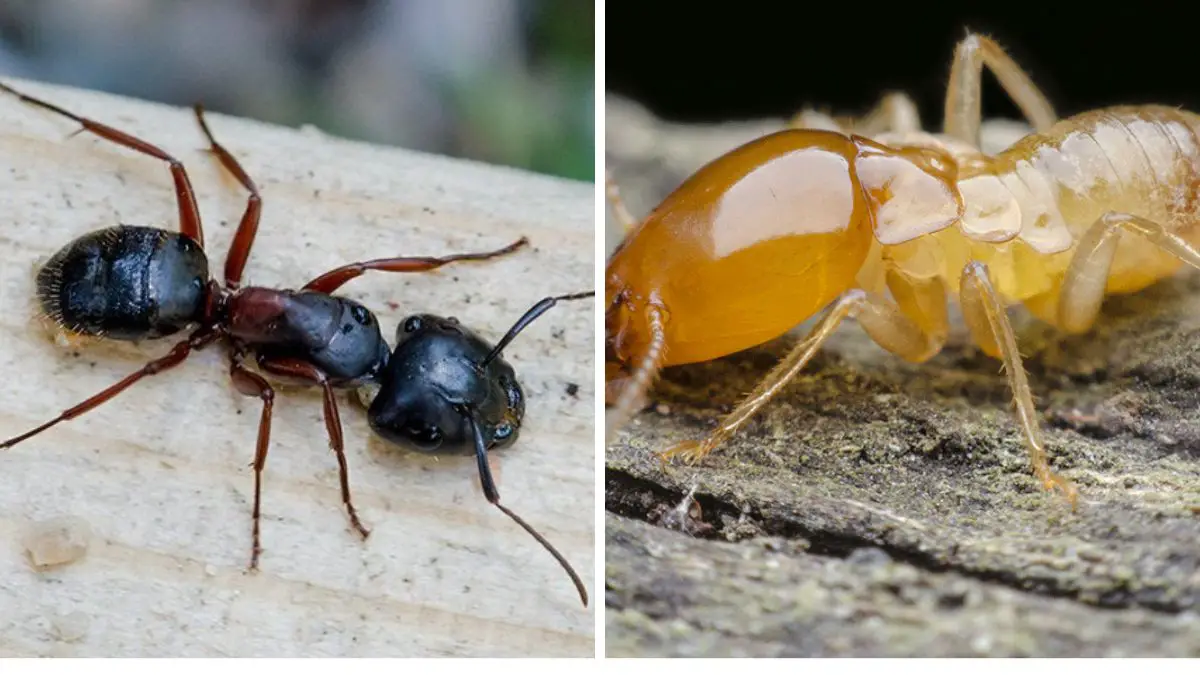Dealing with unwanted pests in our homes can be a stressful experience. Among the most common and destructive ones are carpenter ants and termites.
These tiny creatures may seem similar at first glance, but their distinct characteristics and behaviors set them apart.
This comprehensive guide will delve into the world of carpenter ants and termites, highlighting their unique features, habits, signs of infestation, and effective control methods.
Whether you’re a homeowner, a curious observer, or seeking ways to combat an existing problem, this article will equip you with the knowledge and strategies to tackle these nuisances head-on!
Understanding Carpenter Ants
Carpenter ants, known as Camponotus, are often found in damp or decaying wood. These resilient creatures do not consume the wood but excavate it to build their nests.
Some essential aspects to consider about carpenter ants include:
Physical Characteristics
Carpenter ants are typically larger than termites, measuring from 1/4 to 1/2 an inch in length.
They possess a distinctive body shape with a narrow, segmented waist, bent antennae, and prominent mandibles.
Nesting Habits
Unlike termites, carpenter ants can nest in both moist and dry wood.
They prefer decaying wood, but they can also excavate sound structures, such as wooden beams and furniture.
Diurnal Activities
Carpenter ants are primarily active during the day, especially during warmer months. Spotting roaming worker ants around windows, doors, or food sources may indicate an infestation.
Diet
These foragers primarily seek food sources consisting of insects, sweet nectars, and sugary substances like honeydew.
However, they do not consume the wood they excavate. Rather, they create tunnels and galleries for their nests.
Understanding Termites
Termites, or Isoptera, are notorious for their destructive capabilities on wooden structures.
To differentiate termites from carpenter ants, let’s explore the following key aspects:
Physical Characteristics
Termites are generally smaller than carpenter ants, ranging from 1/4 to 3/8 inches long.
They have a straight waistline, straight antennae, and a soft, pale body that lacks the segmented regions of carpenter ants.
Nesting Habits
Unlike carpenter ants, termites rely on soil contact or moisture sources to establish their colonies.
They build intricate nests within the ground, in tree stumps, or wooden structures.
Termites feed on cellulose material, such as wood, as their primary food source.
Subterranean and Drywood Termites
The two main types of termites are subterranean and drywood termites.
Subterranean termites thrive in soil and create mud tubes to reach above-ground food sources, while drywood termites infest dry wood directly.
Nocturnal Behavior
Termites are predominantly active at night, making it more difficult to detect their presence.
Winged alates, commonly referred to as “swarmers,” are the reproductive stage that emerges to start new colonies.
Signs of Infestation
Now that we understand the distinct characteristics of carpenter ants and termites, let’s identify common signs indicating an infestation:
Carpenter Ant Infestation Signs
- Sightings of foraging worker ants, especially near food sources or entry points
- Rustling or tapping sounds caused by the excavation of wood
- Discarded piles of sawdust, known as “frass,” near damaged wood
- Hollow-sounding wood when tapped or pressed
Termite Infestation Signs
- Mud tubes on foundations, walls, or other surfaces
- Damaged or hollow-sounding wood
- Presence of swarmers (winged termites) near light sources
- Small piles of fecal pellets resembling wood-colored grains
Preventive Measures
Preventing carpenter ant and termite infestations is crucial in maintaining the structural integrity of your home.
Here are some effective preventive measures:
Moisture Control
Since both pests are attracted to moisture, ensure proper ventilation, fix plumbing leaks promptly, and divert water away from the foundation.
Like vapor barriers, moisture barriers can be installed in crawl spaces to discourage infestations.
Wood Maintenance
Regularly inspect and repair any decayed or damaged wood in and around your home. Consider sealing cracks and gaps in foundations, siding, and windows with caulk or appropriate sealants.
Landscape Management
Maintain clearance between soil and wooden structures, such as decks or fences, to minimize the risk of termite infestations.
Trim vegetation and tree branches away from your house to prevent a direct entry point for pests.
The exception to this is plants that naturally repel termites.
Handling Infestations
If preventive measures fail, it’s crucial to address carpenter ant and termite infestations promptly.
Consult a professional pest control service for effective treatment options tailored to your situation.
Common control methods include:
Carpenter Ant Control
- Locating and destroying the nests, often through professional baiting or insecticide treatments.
- Eliminating food and water sources that attract carpenter ants.
- Maintaining regular perimeter treatments as a long-term strategy.
Termite Control
- Applying liquid termiticides to the soil around your property’s foundation to create a protective barrier.
- Installing termite baits and monitoring systems to detect termite activity.
- Fumigating or utilizing targeted spot treatments for severe infestations.
Wrapping it Up
Understanding the differences between carpenter ants and termites is crucial to deal with infestations effectively.
By being aware of their physical characteristics, nesting habits, and signs of infestation, homeowners can take proactive measures to prevent property damage.
Regular inspections, moisture control, and prompt professional intervention are key to managing both carpenter ant and termite problems effectively.
Remember, seeking advice from an experienced pest control company ensures the best course of action for your unique circumstances.

